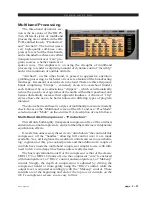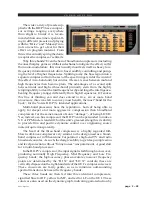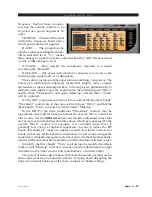
V O R S I S H D P 3 G U I
page 2 – 14
HD P3 / Aug 2006
DEPTH — The maximum
amount the expander is permitted
to reduce the input signal level.
OPEN — The time-constant of
the rate at which the expander un-
attenuates, or opens; sometimes
called “attack”.
HANG — An adjustable pe-
riod of time the expander remains
open without attenuating, before
starting to close. Handy to keep the
expander open during, say, speech
inter-syllables or other short pauses,
without having to resort to exces-
sively long...
CLOSE — ... close times, be-
ing the rate at which the expander
attenuates away the input signal
once below the threshold.
An input/output plot, a graphical representation of the relationships
between threshold, ratio, and depth, is on the Expander Control screen
of the GUI; it is a handy visual aid.
Almost always, the trick is to set the threshold of the expander -
below which it starts to attenuate away the input signal - high enough
to capture the noise, but not too high as to snatch at the lower levels of
the desired parts of the program material. That can sound really
irritating.
Sometimes the gain reduction is required to be subtle so as not to
draw attention to the fact that the expander is in operation; under these
conditions shallow expansion ratios, such as 1:1.5 or 1:2 are preferred,
as are restricted depth - 6dB, or 10dB, is plenty and makes a substantial
subjective improvement to the noise.
These, too, are the kind of settings used for another application of
an expander: effectively shortening an excessively long room rever-
beration time, or an instrument’s ring-out that is overly persistent. In
these cases the threshold is set somewhat higher, well up into the
desired audio levels - in this way the attenuation becomes part of the
overall sound, but the gentle ratio prevents a sense of anything “odd”
happening. Again, relatively shallow depths of 12dB or so are plenty
to achieve the desired effect.
More aggressive expansion, or “gating”, is accomplished with
steep ratios (1:3, 1:5) and with shorter open and close times than for
“unobtrusive”. It is still best not to go overboard with depth - even just
14dB, 20dB tops, is enough to make a signal “disappear” in the context
of a mix; the whole gating sound, especially surprisingly its opening,
is less obvious with shallower depth. Sometimes the “Surprise!”
element is required, though, for effect.






























